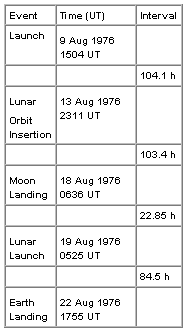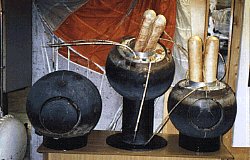Tracking Luna 24 from Florida and Stockholm
Richard Flagg and Sven Grahn
__________________
 Luna
24 turned out to be the last of the Soviet lunar probe series started in
1969. It was a very ambitious flight but provided some baffling experiences
for space trackers. The spacecraft carried a drill that took samples in
a long core sample to a depth of 2 meters. The core sample was in a long
flexible tube that was rolled up inside the return capsule.
(See a picture below of the sample return capsules from Luna 16, 20, and
24 on display at the NPO Lavochkin Museum. Courtesy of Alexander Chernov
and the Virtual Space Museum).
Luna
24 turned out to be the last of the Soviet lunar probe series started in
1969. It was a very ambitious flight but provided some baffling experiences
for space trackers. The spacecraft carried a drill that took samples in
a long core sample to a depth of 2 meters. The core sample was in a long
flexible tube that was rolled up inside the return capsule.
(See a picture below of the sample return capsules from Luna 16, 20, and
24 on display at the NPO Lavochkin Museum. Courtesy of Alexander Chernov
and the Virtual Space Museum).
The flight profile of the
flight is given in the table on the left. The major difference between
Luna 24 and previous two lunar sample-return flights was the duration of
the return flight from the moon. Also, this longer flight time led to a
landing at a much northern latitude after an approach to earth over the
north pole.
When this flight was launched
the Kettering Group swung into action to try to find the signals from Luna
24. Since Sven Grahn tracked the Luna 20 return flight four years earlier,
Dick Flagg had put a 9 meter dish into operation at the University of Florida
and this antenna could now be used to monitor the flight on both 922 MHz
and 183 MHz. Sven Grahn still had the same equipment that was used to receive
Luna 20 on 183 MHz.
According to a telephone
conversation that Dick had with "a well known space tracking facility"
during the flight of Luna 24 it transmitted on 922.764 MHz with "6
kHz FM-telemetry [6 kHz = subcarrier frequency?] and a 3 kHz ranging tone".
It transmitted on this frequency for about 20 minutes on each orbit around
the Moon. The 183 MHz signal would "come up after lift-off" from
the Moon according to Dick's source. The return flight signals on 183.6
MHz was our main tracking target. We did receive signals, but they were
somewhat baffling.
Here is an extract from a
letter from Dick Flagg to Sven Grahn dated 26 September 1976:
 "...Luna
24 was a very strange flight in several ways. It was gratifying to see
that the launch time plotted very near to Luna 18 on my AGE-Declination
Phase plane. It is an interesting observation that all known sample-return
flights have been launched when the declination phase was between 312 and
322 degrees. What about Luna 23 then - was it a different type of mision?
"...Luna
24 was a very strange flight in several ways. It was gratifying to see
that the launch time plotted very near to Luna 18 on my AGE-Declination
Phase plane. It is an interesting observation that all known sample-return
flights have been launched when the declination phase was between 312 and
322 degrees. What about Luna 23 then - was it a different type of mision?
At any rate - the Luna
24 mission profile seemed normal until liftoff from the moon - which was
a few hours early. Stay time on the surface was 0.95 days for Luna 24 compared
with 1.15 days for Luna 20 and 1.1 days for Luna 16. This few hour shorter
stay meant that the liftoff was viewable from Yevpatoria. And now the most
interesting thing that the return flight was 3.52 days rather than 2.84
days for Luna 20 or the 2.9 days for Luna 16.
For Luna 20 and Luna 16
the re-entry to earth was along a direct path from the moon to the earth.
When the probe was launched from the moon, the moon was over the Atlantic.
During the 2.8 day flight the moon moved eastward about 35 degrees and
so when the probe landed on earth the moon was above the longitude of the
landing site.
But Luna 24 was different
- the extra return flight time coupled with the early launch put the landing
site on the back-side of the earth as viewed from the moon. This is the
same geometry that existed for Zonds 6 and 7. I don't necessaerily mean
that it was a skip type reentry, I am only saying the geometry was the
same as when skip reentries were used. It was a definite departure from
the direct ballistic return of Luna 16 and Luna 20......
........Of course one
thing directly affected by the longer return flight was our tracking. Here
is what I got.
Aug 19 [Launch
from the moon took place at 0525 UT]
0724.00-0725.50 UT
very weak CW carrier on
922.76 MHz using 30 ft dish, helical feed
with 2.3 dB NF preamp right at feed. At 0822 UT I installed 183 feed (2
el yagi and 3.1 dB NF preamp) on 30 ft dish. 0826.40 UT very strong
signals on 183.512 MHz +/- 5 or 6 kHz - exactly what Sven heard
from Luna 20 -no question about it. Signals very strong S/N>15 dB, dish
gain about 22 B. 0833 UT command-off. The lift-off took place Aug
19 at 0525 UT. My signals from the returner heard about 3 hours after liftoff
and I assume the 922 was from the descent stage still operating after the
returner blasted off.
Aug 22
[Earth landing took place at 1755 UT]
0033 UT tracking at home
and there is areally band sounding "warbling FSK" on 183.512 MHz - not
sweeping like signals on Aug 19. To use a local expression - sound like
a "raw mule fart". However I did strip out a bit after frequency demodulation
with HP500BR and there is a periodic structure. Signals fade out at 0100.40
UT - command off, not fade out. Once again signals were very sgrong about
15 dB S/N.
During the next few hours
I listen every 20-30 minutes and at 0421 UT note the same signal as before
except now its freq is 183.35 MHz - a change of some 160 kHz. Strip out
shows same structure. 0452.10 UT command-off. Did you hear this same thing
Sven? What the hell was it?...."
In a letter to Richard Flagg
dated 29 August 1976 Sven Grahn wrote:
Luna 24
".....I carefully did
all the calculations and found that the landing should take place Sunday
[22 August] at about 0700 UT, and I listened on 183.54 MHz and other frequencies
for 5 hours before the time and 2 hours after. Nothing - absolutely nothing
similar to what I got from Luna 20. The only thing I had was an unsteady
carrier which faded out at 0751 UT. Frequency 183.50 MHz. ....I don't understand
a thing! What the hell happened?......"
Analysis
Yes, indeed, what happened?
As you can see from the letter quotes above, Dick and I were basing our
tracking activities on the flight profiles of Luna 16 and 20. Therefore,
it can be instructive to recapitulate those and compare them to the flight
profile of Luna 24 (See "Notes
on the design and flight profile of the Luna 15-24 series"). It is
evident that the flight time to earth was about 15 hours longer than for
previous flights. The reason for this change is that the guidance law for
the return flights was based on a simple principle: The probe ascended
vertically from the moon and a component of the velocity relative the moon
at the time of leaving the sphere of influence of the moon (parabolic excess
velocity) nulled out orbital velocity of the moon and made the probe drop
towards earth along a rather straight line. In the case of Luna 24 the
landing longitude was 6 degrees further east and to null out the orbital
velocity of the moon less velocity for the probe was needed, resulting
in a slower return trajectory. The fact that the landing latitude on the
moon was about 10 degrees fiurther north made it easier to achieve a return
trajectory that looped around to the side of the earth facing away from
the moon.
Why did the carrier of the
radio transmitter on 183.6 MHz "warble"? I think that the periods when
this happened represent the flight phases when there was no ranging uplink
transmitted and the onboard oscillator was free-running (and obviously
unstable). The periodic pattern that Dick Flagg detected may have been
the result of the slow roll of the return vehicle. Of course it is gratifying
that the frequency sweeps for ranging purposes were again observed.

 Back
to Space Tracking Notes
Back
to Space Tracking Notes
 Luna
24 turned out to be the last of the Soviet lunar probe series started in
1969. It was a very ambitious flight but provided some baffling experiences
for space trackers. The spacecraft carried a drill that took samples in
a long core sample to a depth of 2 meters. The core sample was in a long
flexible tube that was rolled up inside the return capsule.
(See a picture below of the sample return capsules from Luna 16, 20, and
24 on display at the NPO Lavochkin Museum. Courtesy of Alexander Chernov
and the Virtual Space Museum).
Luna
24 turned out to be the last of the Soviet lunar probe series started in
1969. It was a very ambitious flight but provided some baffling experiences
for space trackers. The spacecraft carried a drill that took samples in
a long core sample to a depth of 2 meters. The core sample was in a long
flexible tube that was rolled up inside the return capsule.
(See a picture below of the sample return capsules from Luna 16, 20, and
24 on display at the NPO Lavochkin Museum. Courtesy of Alexander Chernov
and the Virtual Space Museum).
 "...Luna
24 was a very strange flight in several ways. It was gratifying to see
that the launch time plotted very near to Luna 18 on my AGE-Declination
Phase plane. It is an interesting observation that all known sample-return
flights have been launched when the declination phase was between 312 and
322 degrees. What about Luna 23 then - was it a different type of mision?
"...Luna
24 was a very strange flight in several ways. It was gratifying to see
that the launch time plotted very near to Luna 18 on my AGE-Declination
Phase plane. It is an interesting observation that all known sample-return
flights have been launched when the declination phase was between 312 and
322 degrees. What about Luna 23 then - was it a different type of mision?